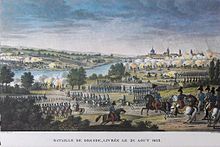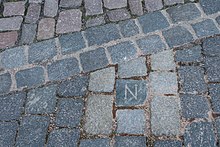Battle of Dresden
| Battle of Dresden | |||||||
|---|---|---|---|---|---|---|---|
| Part of the German campaign of the Sixth Coalition | |||||||
 Battle of Dresden by Carle Vernet and Jacques François Swebach | |||||||
| |||||||
| Belligerents | |||||||
|
|
| ||||||
| Commanders and leaders | |||||||
|
Édouard Mortier | |||||||
| Strength | |||||||
|
100,000[1] 135,000[2] |
200,000[1] 215,000[2] | ||||||
| Casualties and losses | |||||||
| 10,000 killed or wounded[1] |
38,000[2] 14,000 killed or wounded, 24,000 captured, 40 guns | ||||||
Location within Europe | |||||||
The Battle of Dresden (26–27 August 1813) was a major engagement of the Napoleonic Wars. The battle took place around the city of Dresden in modern-day Germany. With the recent addition of Austria, the Sixth Coalition felt emboldened in their quest to expel the French from Central Europe. Despite being heavily outnumbered, French forces under Napoleon scored a victory against the Army of Bohemia led by Generalissimo Karl von Schwarzenberg. However, Napoleon's victory did not lead to the collapse of the coalition, and the weather and the uncommitted Russian reserves who formed an effective rear-guard precluded a major pursuit. Three days after the battle, the Allies surrounded and destroyed a French corps advancing into their line of withdrawal at the Battle of Kulm.
Prelude
On 16 August, Napoleon had sent
The Coalition avoided battle with Napoleon himself, choosing to attack his subordinate commanders as per the
Battle

On 25 August, the three monarchs—
The following day, 26 August,
In Dresden,
Shortly after 11:00am, the Coalition monarchs noticed the stream of French troops hurrying into Dresden from the north. There was a lull in the battle between noon and 3:00pm while the French reinforcements took positions and the Coalition leaders pondered whether they should fight Napoleon or withdraw. The Coalition finally began a bombardment and general assault starting about 3:00pm against the southern suburbs of the city. As the Coalition forces made progress, Napoleon swiftly dispatched reinforcements to the threatened areas – the
After being reinforced overnight with Victor's
As the allied left wing was being disintegrated, the French attacked on the allied right wing with
An effective rear-guard and the weather allowed Schwarzenberg to withdraw and escape any attempt of encirclement or pursuit. The Coalition had lost some 38,000 men and 40 guns. French casualties totaled around 10,000. Some of Napoleon's officers noted he was "suffering from a violent colic, which had been brought on by the cold rain, to which he had been exposed during the whole 2nd day of the battle."[8]
Aftermath

On 27 August,
Napoleon's old rival Jean Victor Marie Moreau, who had only recently returned from his banishment from the United States, was talking to the Tsar (who wished to see Napoleon defeated) and was mortally wounded in the battle, dying later on 2 September in Louny.[9]
Hoffman
The author and composer E. T. A. Hoffmann happened to be in Dresden during the battle, being at the time employed by a locally based orchestra. On 22 August, after the end of the armistice, the Hoffmann Family was forced to relocate from their pleasant house in the suburbs into the town. During the next few days, as the battle raged, they experienced the ongoing bombardments. As Hoffman later recounted, many people were killed by shells directly in front of him. After the main battle was over, he visited the gory battlefield. His account can be found in Vision auf dem Schlachtfeld bei Dresden.[citation needed]
Notes
- ^ a b c d Bodart 1908, p. 455.
- ^ a b c Leggiere 2015, p. 9.
- ^ Maude 1908, pp. 148, 156.
- ^ Smith 2006, pp. 18–21.
- ^ Chandler 1966, pp. 910–911.
- ^ Marbot 2011.
- ^ Smith 2006, p. 445.
- ^ peterswald 2001.
- ^ Enno E. Kraehe, Metternich's German Policy; vol. 1: The Contest with Napoleon, 1799–1814, Princeton University Press, 1963, p. 192.
References
- Bodart, Gaston (1908). Militär-historisches Kriegs-Lexikon (1618-1905). Retrieved 4 June 2021.
- Chandler, David (1966). The Campaigns of Napoleon. Weidenfeld and Nicolson. ISBN 9780025236608. Retrieved 20 May 2021.
- Leggiere, Michael V. (2015). Napoleon and the Struggle for Germany: The Franco-Prussian War of 1813. Cambridge University Press.
- Marbot, Jean-Baptiste Antoine Marcelin (2011). "23". The Memoirs of General Baron de Marbot. Vol. II. Archived from the original on 19 May 2011. Retrieved 20 May 2021.
- Maude, Frederic Natusch (1908). The Leipzig Campaign, 1813. London: Swan Sonnenschein. Retrieved 4 June 2021.
- peterswald (2001). "Memoirs of the Duke of Rovigo". Peterswald. Archived from the original on 14 March 2001.
- Smith, Digby (2006). 1813 Leipzig: Napoleon and the Battle of the Nations.
Further reading
- Lawford, James (1979). Napoleon, The Last Campaigns 1813-1815. New York: Crown Publishers.
- Lorraine, Petre, F. (1977). Napoleon's Last Campaign in Germany in 1813. New York: Hippocrene Books, Inc.
{{cite book}}: CS1 maint: multiple names: authors list (link) - Wimble, Ed. (2015). La Bataille de Dresde. Sassamansville, PA: Clash of Arms Games.
External links
- Battle of Dresden 1813 – maps, illustrations
- Battle of Dresden 1813 Allied Order of Battle
- Battle of Dresden 1813 French Order of Battle
- French Garrison of Dresden, 22 August 1813 (George Nafziger collection)
- Allied Forces at Dresden, 26/27 August 1813 (George Nafziger collection)
- French Forces at Dresden, 26/27 August 1813 (George Nafziger collection)
- Memoirs of the Duke Rovigo
 Media related to Battle of Dresden at Wikimedia Commons
Media related to Battle of Dresden at Wikimedia Commons
| Preceded by Battle of the Katzbach |
Napoleonic Wars Battle of Dresden |
Succeeded by Battle of Kulm |



